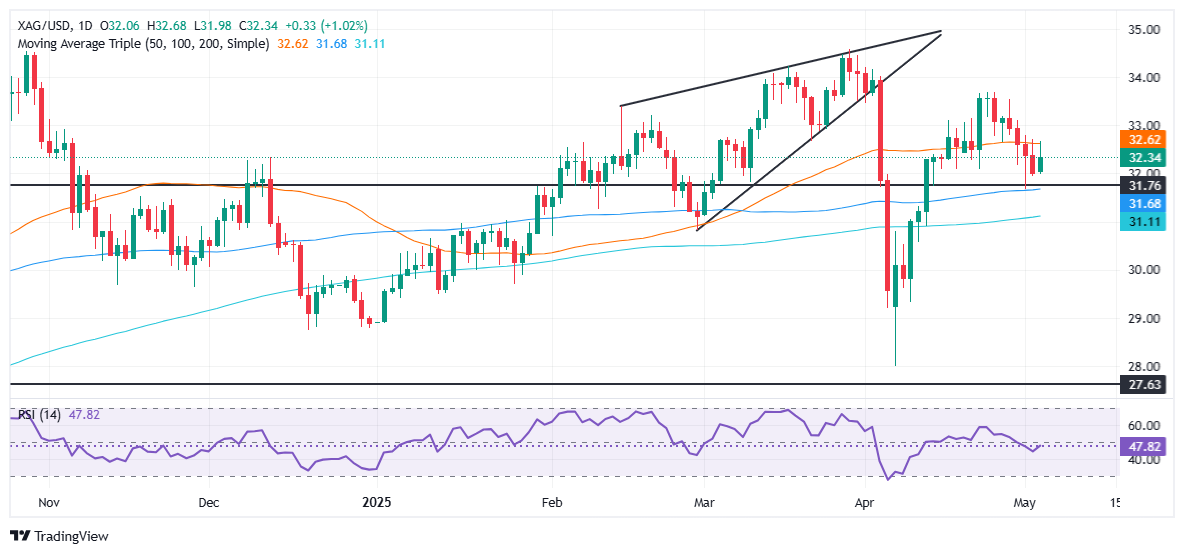Silver Price Forecast: XAG/USD rises past $33.00 on weak US Dollar
- Silver finds support amid weaker US Dollar and renewed haven demand sparked by Trump’s tariff push.
- XAG/USD stabilizes in $31.67–$32.61 range; upside capped by 50-day SMA.
- Break above $33.50 could target $34.00, while drop below $31.67 eyes 200-day SMA at $31.11.
Silver's price advanced close to 1% on Monday, as the US Dollar (USD) remains pressured due to US President Donald Trump's tariffs and appetite for the haven’s appeal of precious metals like Gold and the grey metal. At the time of writing, XAG/USD is at $32.30 after bouncing off daily lows of $31.98.
XAG/USD Price Forecast: Technical outlook
Since peaking on March 28 at $34.58, Silver tumbled to $28.33, a six-month low, before recovering some ground. Still, buyers were unable to reach the $34.00 mark, and for the last three trading days, it stabilized within the $31.67-$32.61 range.
The Relative Strength Index (RSI) shows that momentum favors sellers as the RSI turned bearish on May 1, and XAG/USD slipped through the 50-day Simple Moving Average (SMA) at $32.61.
However, if buyers push XAG/USD past $33.50 on a daily closing, look for a test of $34.00. On the other hand, a breach of $33.00 could send the grey metal to test the 100-day SMA at $31.67. If surpassed, the next stop would be the 200-day SMA at $31.11.
XAG/USD Price Chart – Daily

Silver FAQs
Silver is a precious metal highly traded among investors. It has been historically used as a store of value and a medium of exchange. Although less popular than Gold, traders may turn to Silver to diversify their investment portfolio, for its intrinsic value or as a potential hedge during high-inflation periods. Investors can buy physical Silver, in coins or in bars, or trade it through vehicles such as Exchange Traded Funds, which track its price on international markets.
Silver prices can move due to a wide range of factors. Geopolitical instability or fears of a deep recession can make Silver price escalate due to its safe-haven status, although to a lesser extent than Gold's. As a yieldless asset, Silver tends to rise with lower interest rates. Its moves also depend on how the US Dollar (USD) behaves as the asset is priced in dollars (XAG/USD). A strong Dollar tends to keep the price of Silver at bay, whereas a weaker Dollar is likely to propel prices up. Other factors such as investment demand, mining supply – Silver is much more abundant than Gold – and recycling rates can also affect prices.
Silver is widely used in industry, particularly in sectors such as electronics or solar energy, as it has one of the highest electric conductivity of all metals – more than Copper and Gold. A surge in demand can increase prices, while a decline tends to lower them. Dynamics in the US, Chinese and Indian economies can also contribute to price swings: for the US and particularly China, their big industrial sectors use Silver in various processes; in India, consumers’ demand for the precious metal for jewellery also plays a key role in setting prices.
Silver prices tend to follow Gold's moves. When Gold prices rise, Silver typically follows suit, as their status as safe-haven assets is similar. The Gold/Silver ratio, which shows the number of ounces of Silver needed to equal the value of one ounce of Gold, may help to determine the relative valuation between both metals. Some investors may consider a high ratio as an indicator that Silver is undervalued, or Gold is overvalued. On the contrary, a low ratio might suggest that Gold is undervalued relative to Silver.

